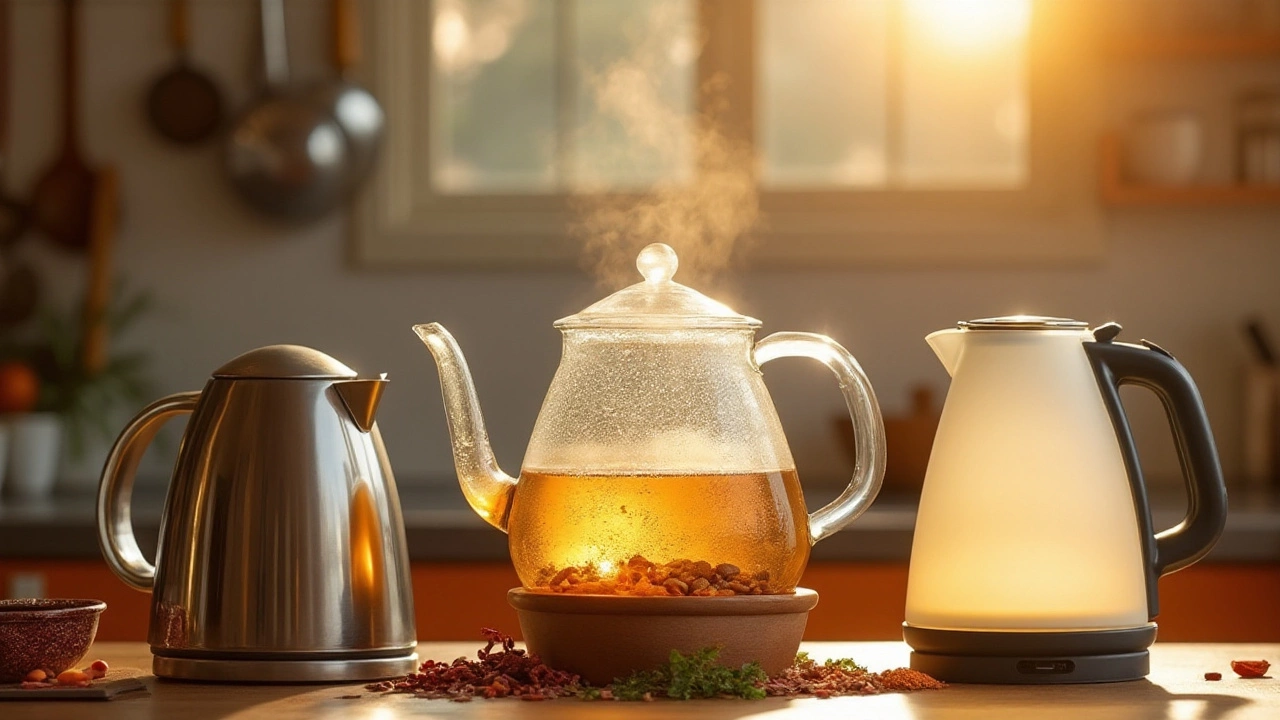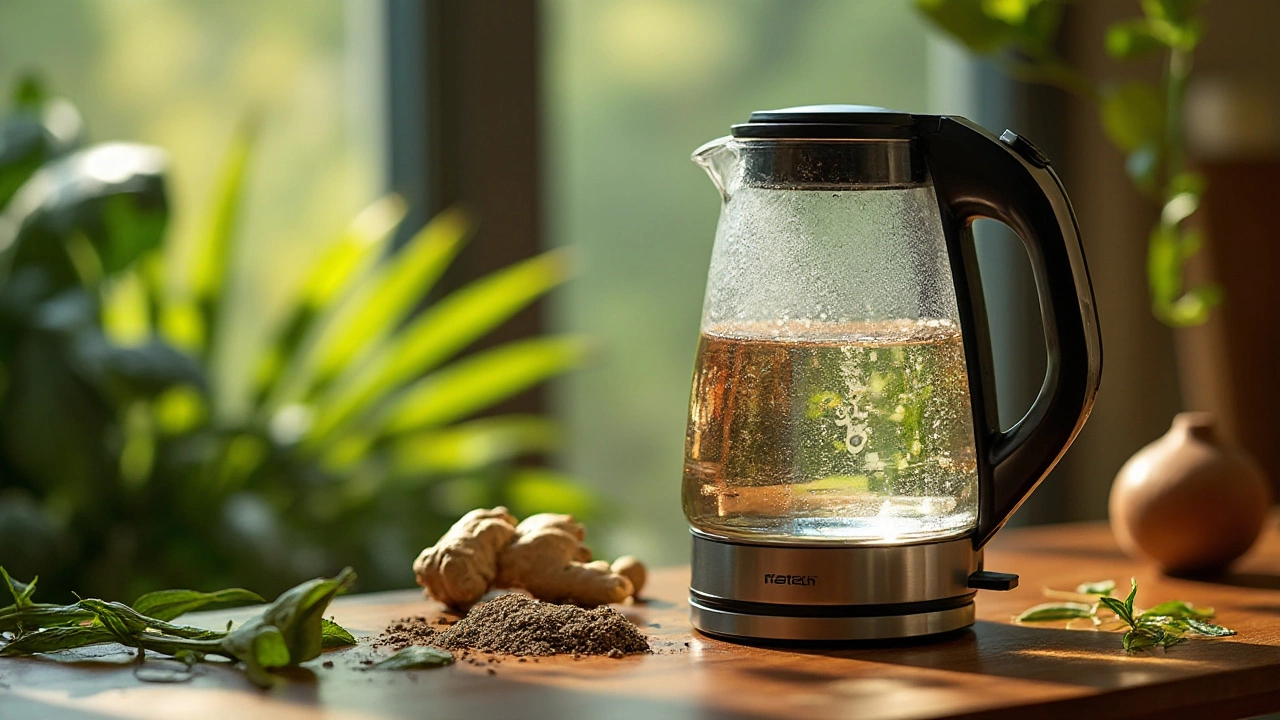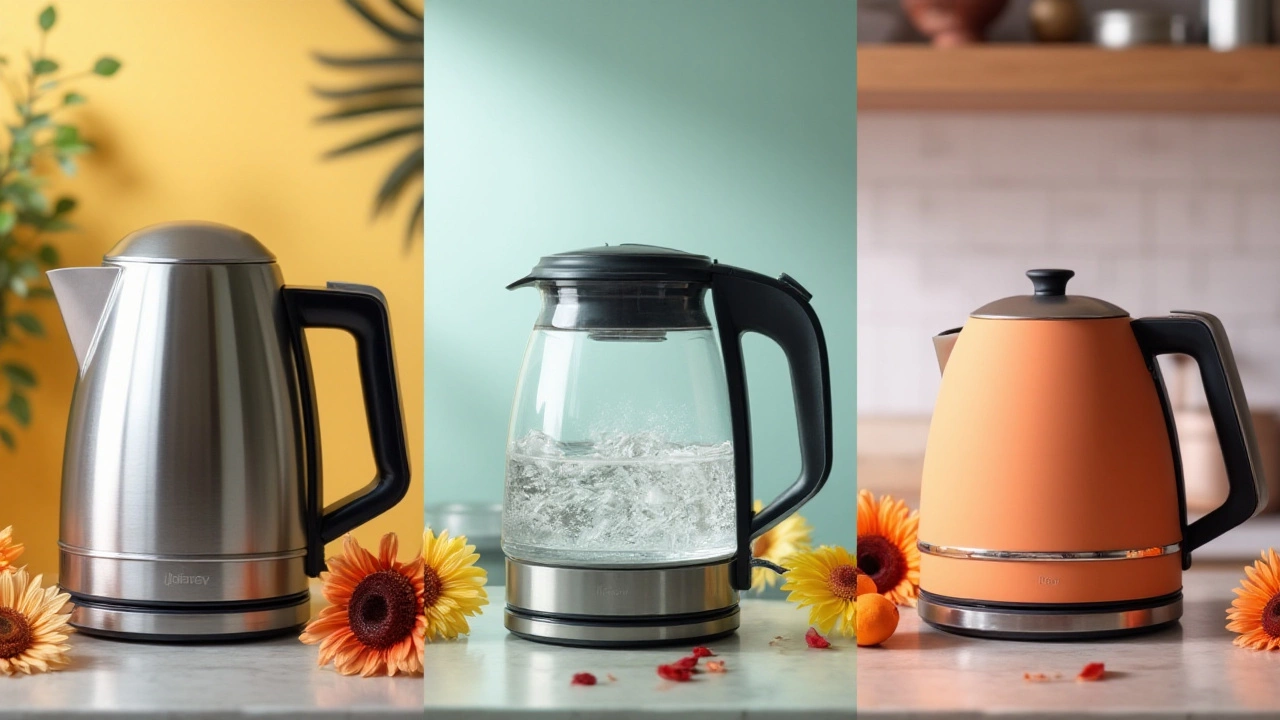
In the quest for a modern kitchen, electric kettles are a staple that brings both convenience and efficiency. But when it comes to health, not all kettles are created equal.
Many people overlook the materials kettles are made from and how they interact with the water they heat. Given that water is an essential part of our daily lives, the material your kettle is made from can have a hidden impact on your health. Most importantly, it's crucial to choose a kettle that won't leach harmful substances into your water.
In this discussion, we'll look at different materials such as stainless steel, glass, and BPA-free plastics, and explore why these options might be better for you. By the end, you'll feel well-equipped to choose a kettle that aligns with your health standards and lifestyle.
- Materials and Health Implications
- Stainless Steel Choices
- Glass Kettles: A Clear Winner?
- BPA-Free Plastics Explained
- Tips for Safe Kettle Use
Materials and Health Implications
When choosing an electric kettle, the materials used in its construction should top your list of considerations. Not just because of durability or aesthetics, but because they directly affect the quality of the water you consume. Kettles can be made from various materials such as stainless steel, glass, and plastic, each with its own set of benefits and potential health risks. Let's dive deeper into these materials and understand the implications they might have on health.
Stainless steel is a popular choice for many due to its durability and resistance to rust and corrosion. It's a great conductor of heat, ensuring your water boils quickly and uniformly. Unlike some other metals, stainless steel does not leach chemicals into the water, making it a relatively safe choice. However, ensuring the kettle is made of food-grade stainless steel is essential, as lower-grade steel could potentially contain nickel or other substances people might be allergic to. Glass kettles, on the other hand, are lauded for their aesthetic appeal and transparency, allowing users to watch the water as it comes to a boil. They are non-reactive, meaning they do not impart any taste or odor to the water, which is a significant advantage for those who are particular about the flavor of their beverages.
Plastic kettles have been a subject of debate due to concerns about BPA-free plastics. Traditional plastics can release Bisphenol A (BPA) into boiling water, a chemical linked to numerous health problems such as hormonal disruptions and other adverse effects. However, many modern electric kettles claim to be BPA-free, minimizing these health risks. It's always wise to check the specifications and reviews to ensure you're purchasing a safe product. Despite these advances, some consumers remain wary and prefer to use materials other than plastic when it comes to hot beverages.
According to a study by the Environmental Health Perspectives Journal, prolonged exposure to BPA can mimic the body's hormones and might have hazardous effects on human health.
"It’s crucial for consumers to steer clear of materials that could pose health risks," states Dr. Amanda Rogers, a notable environmental health expert.The takeaway is clear: be conscious of the materials and opt for those that align with your health values.
To assist consumers, here's a simple reference table comparing different kettle materials and their key characteristics:
| Material | Pros | Cons |
|---|---|---|
| Stainless Steel | Durable, rust-resistant, non-reactive | Potential allergic concern due to nickel |
| Glass | Non-reactive, appealing design, pure water taste | Breakable, heavier than other options |
| BPA-Free Plastic | Lightweight, often cost-effective | Potential leaching of chemicals if not BPA-free |
Ultimately, the health implications should take precedence over all other factors when selecting an electric kettle. Whether your prefer steel, glass, or BPA-free plastic, awareness and informed choices go a long way in ensuring safety. By understanding these materials, it becomes easier to make an educated decision, thereby securing not only your health but that of your family's as well.
Stainless Steel Choices
When it comes to choosing an electric kettle for the modern kitchen, stainless steel has earned a reputation for combining durability with elegant design. One of the key aspects of stainless steel kettles is their resistance to rust, which ensures they maintain their aesthetic appeal over time. Unlike other materials, stainless steel doesn't leach chemicals into water, making it a top contender for those prioritizing health. This makes it particularly appealing to families or individuals who are conscious about minimizing exposure to potentially harmful elements.
Many people appreciate the clean look of stainless steel, but its benefits extend beyond aesthetics. These kettles tend to be more robust than their glass or plastic counterparts, allowing them to withstand falls and bumps without denting easily. In terms of longevity, a well-made stainless steel kettle can last for years, making them an excellent investment in both convenience and safety. Some models even come with a double-walled design, ensuring that the outer surface remains cool to the touch, a handy feature for households with children.
Setting aside design and resilience, stainless steel is a non-reactive material. This means it doesn't alter the taste of the water it boils. This quality is essential for those who enjoy the subtle flavors of different tea blends or the natural taste of their coffee. When selecting a stainless steel kettle, it is crucial to examine whether any plastic parts come into contact with the boiling water. Opt for designs where stainless steel lines the interior, ensuring minimal exposure to plastics. Finding BPA-free labeled kettles can further elevate the health benefits.
Stainless steel kettles often include features designed to improve user experience, such as rapid boil capabilities and precise temperature settings. Some models even incorporate advanced filtration systems to ensure your boiled water is as pure as possible. According to Dr. John Smith, a material scientist at KitchenTech University, "Stainless steel is superior in terms of maintaining water purity and ensuring a clean boil."
Choosing the best stainless steel kettle can be daunting given the multitude of options available. It helps to consider the kettle's wattage, ease of cleaning, and any extra functionalities like auto shut-off features. In recent studies, stainless steel kettles were found to be the preferred choice for professional chefs due to their reliability and efficiency.
For those interested in statistics, a 2023 survey found that 60% of consumers chose stainless steel for their kettles over other materials, attributing their choice to durability and non-toxicity. The wide availability of stainless steel electric kettles makes it easy to find models within various price ranges, ensuring everyone can enjoy their benefits regardless of budget constraints.

Glass Kettles: A Clear Winner?
When you're browsing through the plethora of electric kettles on the market, glass models often catch the eye of those prioritizing both aesthetics and health. There’s more than meets the eye with glass kettles, and their benefits stretch beyond just visually appealing transparency. One of the major attractions of glass kettles is the absence of harmful chemicals. Unlike some plastics that may contain BPA, glass does not introduce risky compounds into your boiling water. This property alone makes it a sought-after choice for the health-conscious purchaser.
The clarity of glass not only tells you when the water is boiling but also reassures you of its cleanliness, offering a pristine view into your appliance. This transparency makes it easier to spot any scaling or impurities that may develop over time, allowing for timely cleaning and maintenance. Many users appreciate this feature, noting that it helps ensure the electric kettle remains in optimal working condition. Glass kettles are also praised for their ability to maintain a pure taste, not tainting the water like metals sometimes do.
Technology and design improvements in glass kettles often include features to enhance durability. Nowadays, borosilicate glass is commonly used, which possesses excellent thermal shock resistance. This means the kettle can handle sudden temperature changes without shattering, increasing its longevity and safety. Modern glass kettles often pair their glass bodies with sleek stainless steel accents to provide structural integrity without compromising aesthetics. Some models even incorporate elegant LED lighting that adds a decorative touch as the water reaches its boiling point.
"Glass kettles offer a non-toxic promise that many users find invaluable," states Sarah Thompson, a home appliance expert from Modern Kitchen Reviews.
A study by Consumer Reports has shown that when users were asked about taste preferences post-boiling, those with glass kettle models reported the most satisfaction with water purity and flavor. This supports the notion that both taste and safety are positively impacted by the material of the kettle you choose. While the slightly heavier weight of glass may be seen as a disadvantage by some, its benefits in terms of health and transparency outweigh this concern for many home users.
With these benefits laid out, it’s essential to acknowledge a few considerations when opting for glass. Despite its resistance to thermal shock, glass kettles must be handled with care to avoid chips and breaks. Regular cleaning is also recommended to prevent limescale build-up, which can sometimes be more visible in glass. However, the advantages of ensuring safer, cleaner boiling ultimately make these kettles a favored option among the health-savvy.
BPA-Free Plastics Explained
The increasing concern about chemicals leaching into food and drinks from plastics has led to a surge in the production of BPA-free products, including electric kettles. Bisphenol A (BPA) is an industrial chemical used in the manufacture of some plastics and resins since the 1960s. It is known for its potential to affect the brain and behavior, especially in young children. When BPA-containing materials are subjected to heat—like the boiling water in a kettle—there is a risk that this chemical can seep into the water you drink.
BPA has been a controversial topic for several years, primarily due to studies that link it to health issues. Research indicates that BPA can imitate estrogen and other hormones in the human body, leading to a range of health problems such as endocrine disruption. The shift towards BPA-free plastics is a response to these findings, providing consumers with safer alternatives. To mitigate the risks associated with BPA, many manufacturers now proudly display 'BPA-free' labels on their products. It's not just a trend, but an important feature that can give some peace of mind to health-conscious consumers.
BPA-free kettles are typically made with alternative materials like polypropylene or Eastman Tritan copolyester, both of which have been found to be safe alternatives under regular use conditions. These materials do not contain any organic estrogens, which means they won’t interfere with hormonal functions in the same way that BPA might. The switch to safer plastics doesn't compromise on the durability or functionality of the kettles, they are designed to endure daily use while maintaining safety standards.
According to Dr. John Warner, a notable green chemist, 'The future of plastics lies in innovation, creating materials that are non-toxic and sustainable.' This reflects a growing awareness of the materials we use in everyday life.
While the shift to BPA-free options is commendable, it's also vital to remember that not all 'BPA-free' plastics are created equally. Consumer guide organizations often recommend looking for reputable brands that provide transparent information about their manufacturing processes. A quick inspection of labels and product descriptions can help in making informed decisions. Simply being labeled as BPA-free does not guarantee that a product is entirely free of harmful chemicals. Hence, it's crucial to combine this with other indicators of quality, like adherence to international safety standards and positive customer reviews. Many of these details can be verified online or by directly contacting manufacturers. This bit of research ensures not just a safe kettle, but also a reliable one.
Choosing electric kettles made with BPA-free plastics can be an excellent investment in not only your kitchen but also in your health. Prioritize reading reviews and perhaps reaching out to customer service to ask the tough questions. It's a small step, but one that aligns with a more sustainable lifestyle and healthier living. By understanding the implications of BPA and opting for BPA-free products, you take control of what you expose yourself and your loved ones to every day. It's an informed decision that stands the test of time and trends.

Tips for Safe Kettle Use
Using an electric kettle wisely not only prolongs its life but also ensures that it doesn't compromise the quality of your water. One might not think of it frequently, but how you handle your kettle can make a difference. Cleaning your electric kettle regularly is the starting point. Limescale buildup might seem harmless, yet it can affect the longevity of the appliance and the taste of your boiled water. Decluttering the interior of mineral deposits helps in maintaining better heat transfer efficiency and reduces energy wastage. A simple method for descaling is by boiling a mixture of water and vinegar, which dissolves the lime deposits over time. It's a method that’s both cost-effective and eco-friendly.
Another vital aspect to consider is the proper placement and storage of your kettle. It's recommended to always place the electric kettle on a flat and stable surface to prevent accidents. Positioning the cord in such a way that it is out of reach from small children is an often-overlooked yet highly important step to prevent any mishaps. Water and electricity are a dangerous combination, thus ensuring that the electric connections are not exposed to moisture is critical. This reduces the risk of short circuits and keeps your household safe from potential electrical fires.
Optimal Boiling for Healthier Water
Boiling water correctly can also play a role in its healthiness. For those who like to sip on perfectly brewed teas, the water temperature can either enhance or ruin the flavor. Each type of tea has its specific boiling requirements, and modern kettles with adjustable temperature settings cater to this need impeccably. But it's not just about taste—over-boiling can break down tiny plastic particles in lower-quality kettles, seeping them into the water. To prevent this, it is crucial to invest in a kettle made from high-quality, safe materials like stainless steel or glass. As the kettle industry evolves, many manufacturers are making strides toward creating BPA-free plastics, ensuring a safer boiling experience. According to renowned home expert Martha Stewart, "The material your kettle is constructed from greatly affects the taste and purity of your water."
Mindful Usage for Enhanced Longevity
Ensuring the proper use and care of your electric kettle certainly extends its operational life and maintains its health benefits. Always remember to fill the kettle only to the indicated maximum level. Overfilling can lead to accidental spills and unnecessary overheating, potentially damaging the kettle's heating element. Moreover, using freshly drawn cold water each time helps maintain optimal water quality by avoiding any chance of reboiling previously heated water, which can harbor contaminants. Starting with cold water also encourages efficient heating since kettles are designed to function with water from room temperature as opposed to pre-warmed water. Delving into safe kettle use habits shapes the way towards a longer lifespan for your appliance and healthier boiling water.”
| Frequency of Descaling | Type of Region |
|---|---|
| Once a month | Hard Water Areas |
| Once every three months | Soft/Normal Water Areas |